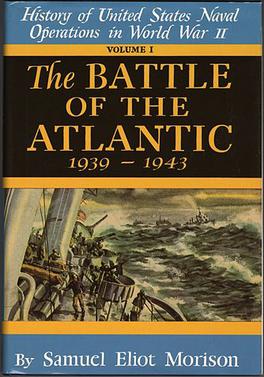History of United States Naval Operations in World War II facts for kids
The History of United States Naval Operations in World War II is a huge collection of 15 books. It tells the story of the United States Navy during World War II. Samuel Eliot Morison wrote these books. They were published by Little, Brown and Company between 1947 and 1962.
Contents
How the Books Started
Right after the attack on Pearl Harbor, Samuel Eliot Morison had an idea. He was already a famous writer. He had written about Christopher Columbus's sea voyages. Morison believed it was important to experience things firsthand. So, he wrote to President Roosevelt. He suggested writing an official history of the Navy in the war. He even volunteered to do it himself!
President Roosevelt and the Secretary of the Navy, Frank Knox, liked the idea. In May 1942, Morison joined the United States Naval Reserve. He became a Lieutenant Commander. He got a team of helpers. He also had permission to go anywhere and see all official records. Morison was known as a great sailor. This helped him get welcomed on many ships. He visited eleven ships by the end of the war.
The books were a normal history, not a strict "official" one. James Forrestal was the Secretary of the Navy from 1944 to 1947. He said that the Navy helped Morison a lot. They let him do deep research. They also let him get firsthand experiences. But Forrestal made it clear: "This work, however, is in no sense an official history." This meant Morison wrote it in his own style. The ideas and conclusions were all his. He only had to keep national security information safe.
Why These Books Are Important
Morison understood that writing history right after events has limits. He knew that new facts might appear later. He also knew that some information was still secret. For example, details about codebreaking were classified then. Later research did clear up some points. Morison even updated some parts in later printings.
He chose not to analyze everything deeply. For example, he didn't focus on why Japan attacked Pearl Harbor. He left that for other books. Morison wrote these books for "the general reader." This means he wanted regular people, not just professional sailors, to enjoy them. He wanted to capture the feeling of the war. He wrote about the urgency, the excitement of battle, and the sadness for lost shipmates.
The Books in the Series
The series has 15 volumes. Each book covers a different part of the Navy's actions in World War II. Morison later wrote a shorter version of the whole series in 1963.
From Books to TV: Victory at Sea
These history books also helped create a famous TV show. One of Morison's research assistants was Henry Salomon. Salomon knew Robert Sarnoff from NBC. In 1949, Salomon suggested a big TV series. It would be about the U.S. Navy and Marine Corps in World War II.
In 1951, the National Broadcasting Company hired Salomon. He produced the TV series Victory at Sea. It aired from 1952 to 1953. This show was a huge success. It used real combat footage. Its popularity helped make historical documentaries a popular type of TV show.


